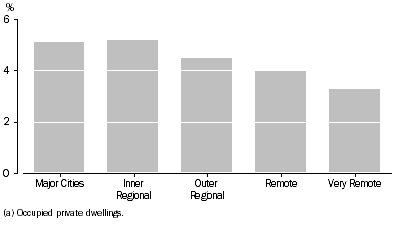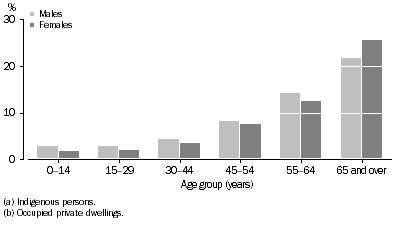INTRODUCTION
This chapter explores disability in the Indigenous population through analysis of the Census 'Need for assistance' questions. The 2006 Census 'Core Activity Need for Assistance' concept is a disability measure comprising a set of four questions: one for each of the core activity areas of self-care, mobility, and communication, and an additional question to ascertain why assistance with core activities was needed.
These Census-based indicators of disability in the Indigenous population are consistent with the relatively high disability rates among Indigenous people aged 15 years and over reported in previous surveys.
For more information on the 'Core Activity Need for Assistance' concept and how it relates to the Survey of Disability, Ageing and Carers (SDAC) and 2002 National Aboriginal and Torres Strait Islander Social Survey (NATSISS) concepts, refer to the Explanatory Notes.
More detailed analysis of need for assistance will be available in The Health and Welfare of Australia's Aboriginal and Torres Strait Islander Peoples 2007 (cat. no. 4704.0) due for release in April 2008. This publication will present detailed analysis of data from the 2006 Census to explain the relationship between the new 'Core Activity Need for Assistance' measure and selected socioeconomic indicators such as educational attainment, labour force participation, income, language spoken at home, and marital status. Also discussed in more detail are differences between collections relating to this topic, including comparability issues.
Proportions presented in this chapter exclude not stated responses, and are therefore calculated using only known responses. Where possible, the numbers of unknown responses are noted in the tables, allowing further analysis if required.
Comparison with non-Indigenous people
The likelihood of an individual needing assistance for core activities is strongly linked with their age, and it is known that the age structure of the Indigenous population is significantly different to that of the non-Indigenous population (see Chapter 2: Population Distribution and Structure). Differences observed in need for assistance data between the two populations at an aggregate level will be compounded by the effect of the different age structures. Therefore, it is recommended that need for assistance data is compared by age groups, or alternatively, that age standardisation is used if data is to be compared at an aggregate level. For information on age standardisation, see the Explanatory Notes.
NEED FOR ASSISTANCE
In the 2006 Census, around 19,600 Aboriginal and Torres Strait Islander Australians (5% of known responses) were identified as needing assistance with self-care (eating, washing, dressing or toileting), mobility or communication. Indigenous people in non-private dwellings were three and a half times more likely to require assistance (15%) than Indigenous people in occupied private dwellings (4%). Non-private dwellings include nursing homes and other carer accommodation. Among Indigenous people in non-private dwellings, need for assistance was significantly higher in nursing homes 93%, hostels for the disabled 77% and accommodation for the retired or aged 76% compared with other types of non-private dwellings.
Remoteness Areas
Indigenous people in Major Cities (5%) and Inner Regional areas (5%), were most likely to require assistance. Rates were only marginally lower in Outer Regional areas (5%), Remote (4%) and Very Remote (3%) areas.
Need for Assistance By Remoteness Area(a), Indigenous persons

Prevalence by age and sex
The following analysis is restricted to people living in private dwellings. It excludes nursing homes and other carer accommodation dwelling types, where there are higher rates of people requiring assistance with self care.
Among those needing assistance, the median age for Indigenous males was 41 years, and for females, 49 years. The corresponding median ages for non-Indigenous males and females who needed assistance were 61 years and 75 years respectively.
The prevalence of need for assistance with core activities increased noticeably from about 35 years of age onwards for both Indigenous men and women. This is consistent with the patterns of chronic long-term health conditions such as, heart/circulatory diseases and diabetes, which show onset some 10 years earlier in the Indigenous population than in the non-Indigenous population (National Aboriginal and Torres Strait Islander Health Survey 2004-5 (cat. no. 4715.0)).
In most age groups, Indigenous males were more likely than females to require assistance. The proportion of Indigenous males aged 0-14 requiring assistance was 3%, compared with 2% for females. In the 65 years and over age group, the proportion of females (26%) identifying the need for assistance was greater than males (22%).
NEED FOR ASSISTANCE(a)(b), by Age group

 Print Page
Print Page
 Print All
Print All